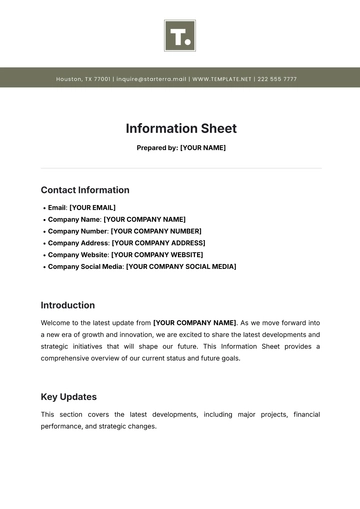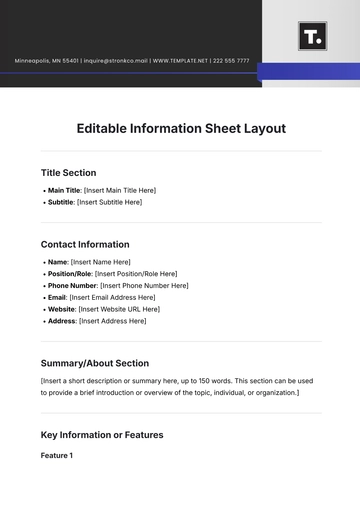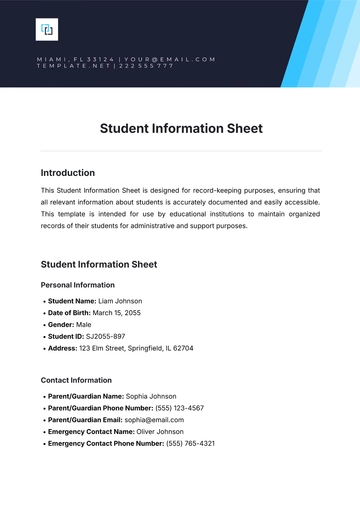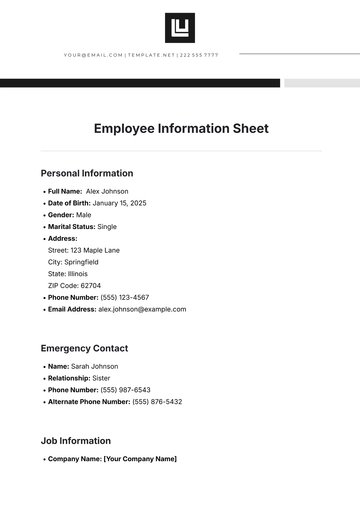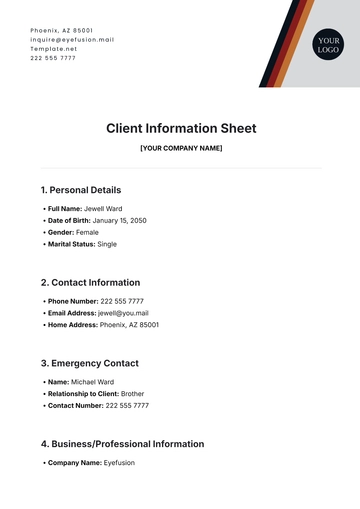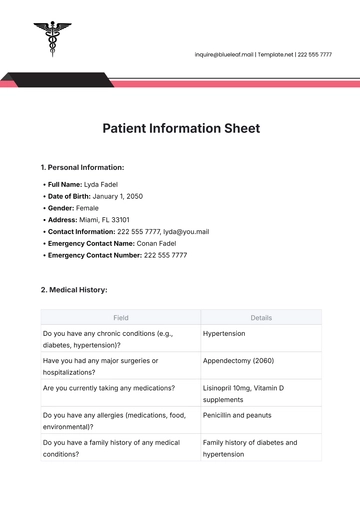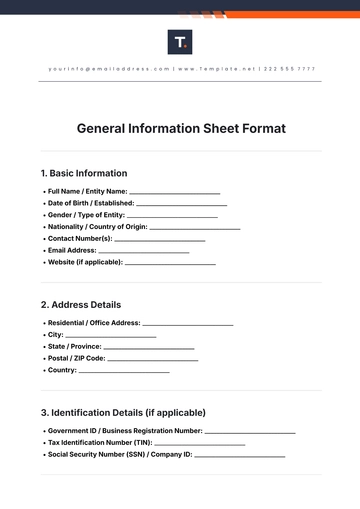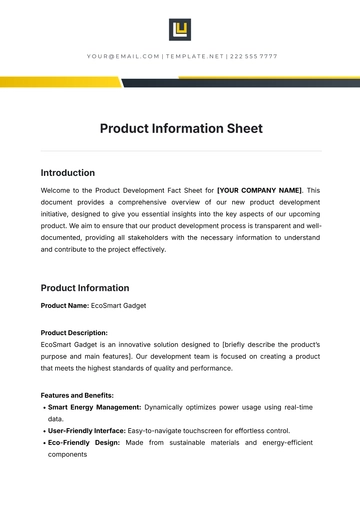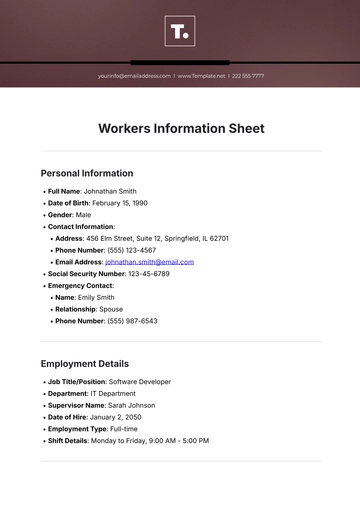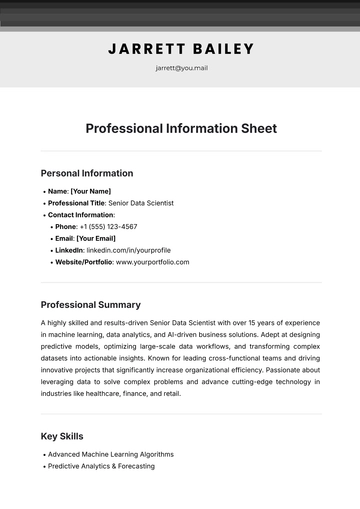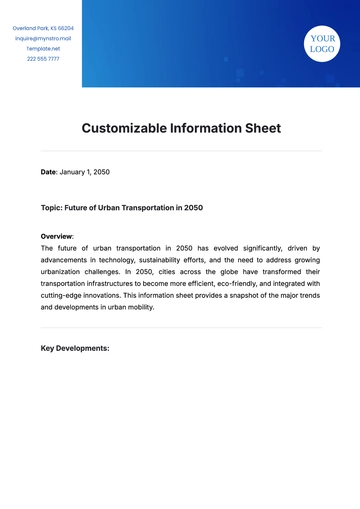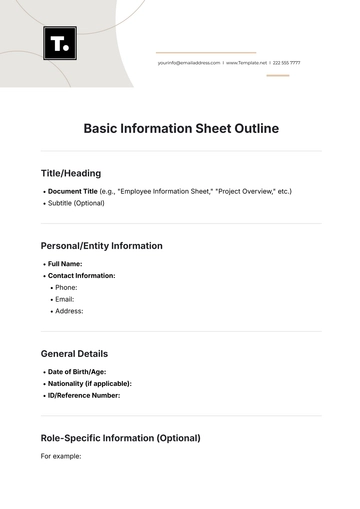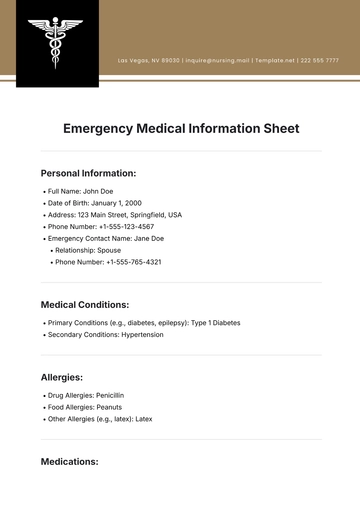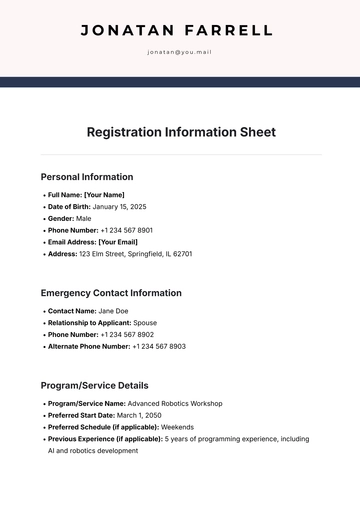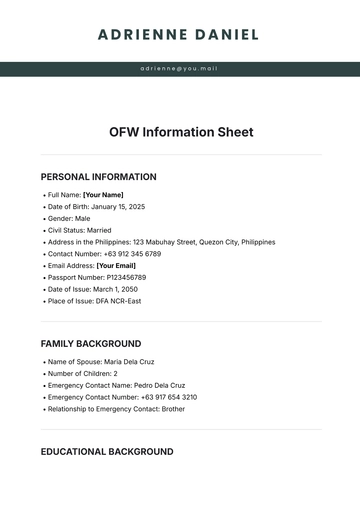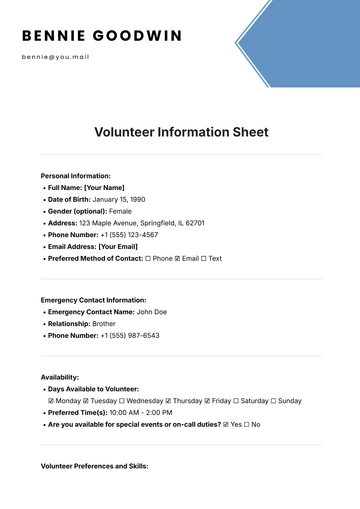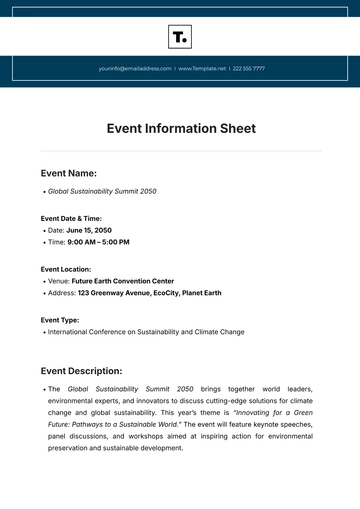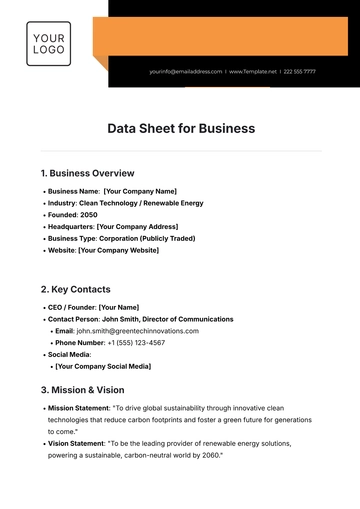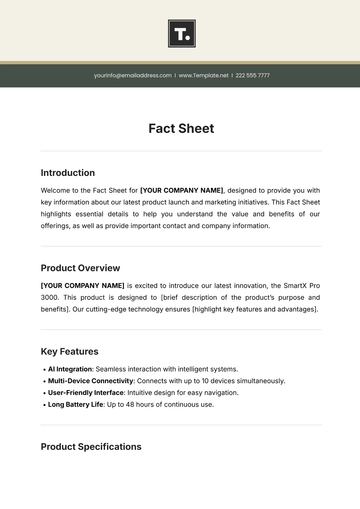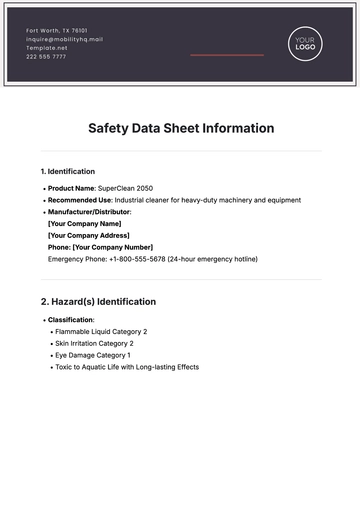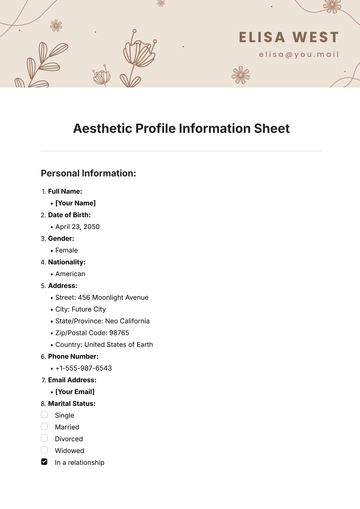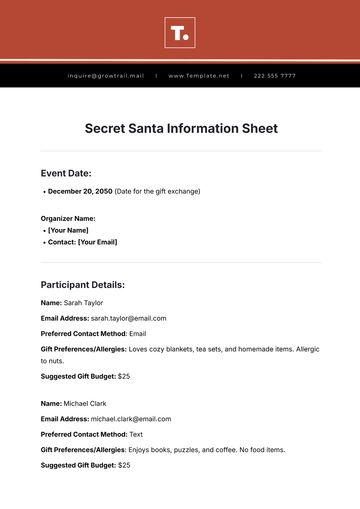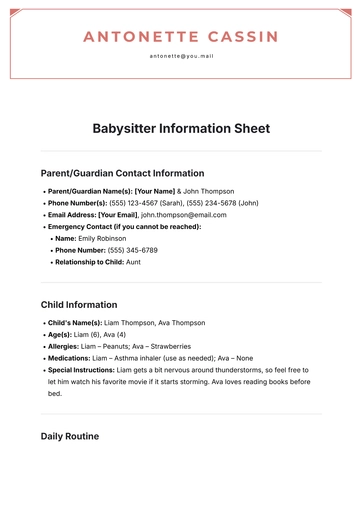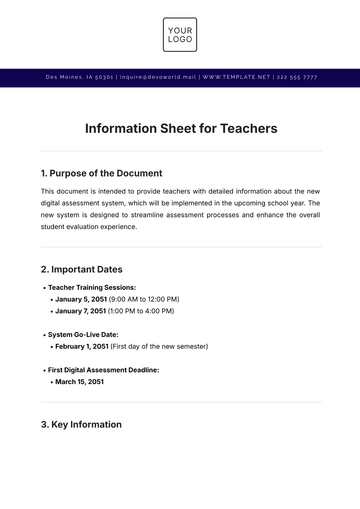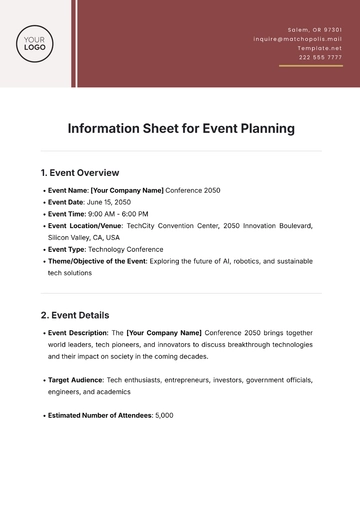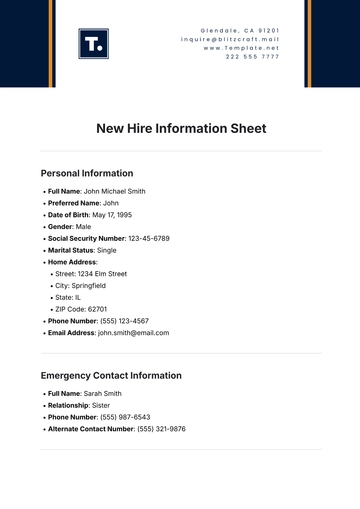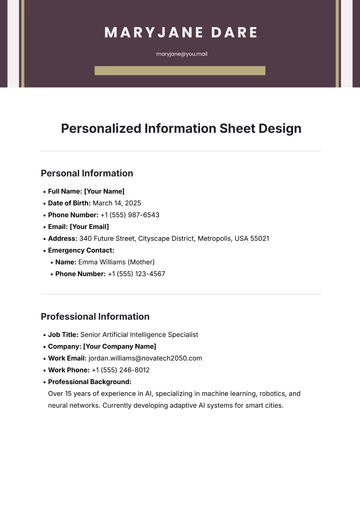Free Material Safety Datasheet
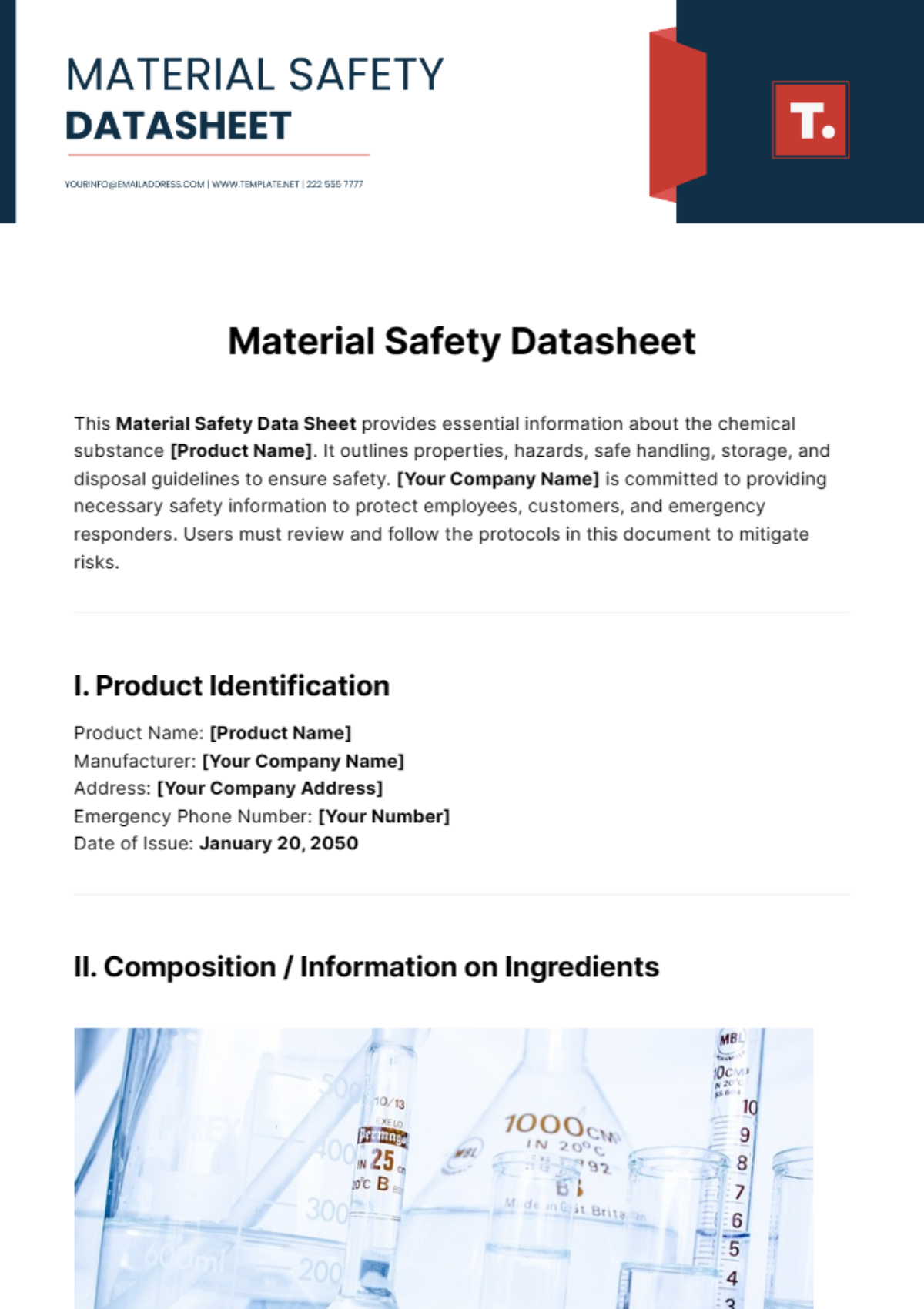
This Material Safety Data Sheet provides essential information about the chemical substance [Product Name]. It outlines properties, hazards, safe handling, storage, and disposal guidelines to ensure safety. [Your Company Name] is committed to providing necessary safety information to protect employees, customers, and emergency responders. Users must review and follow the protocols in this document to mitigate risks.
I. Product Identification
Product Name: [Product Name]
Manufacturer: [Your Company Name]
Address: [Your Company Address]
Emergency Phone Number: [Your Number]
Date of Issue: January 20, 2050
II. Composition / Information on Ingredients
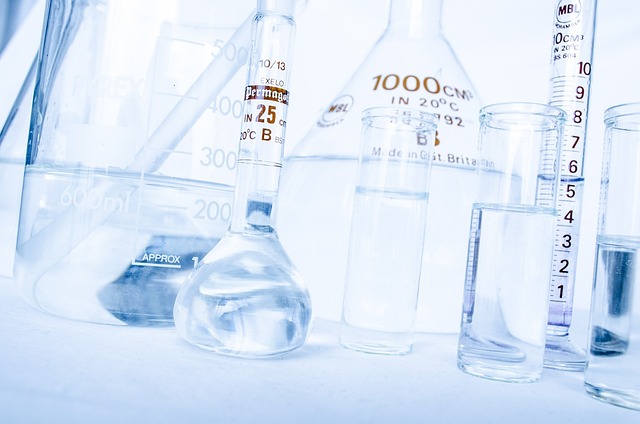
Chemical Name: Methylene Chloride
Common Name: Dichloromethane
CAS Number: 75-09-2
Percentage: 99%
Ingredient | CAS Number | Percentage (%) |
|---|---|---|
Methylene Chloride | 75-09-2 | 99% |
Stabilizer | 123-45-6 | 1% |
III. Hazards Identification
Emergency Overview
Appearance: Clear, colorless liquid
Physical State: Liquid
Odor: Sweet, chloroform-like odor
Potential Health Effects
Eye Contact: Exposure may cause irritation, redness, and watering of the eyes. In severe cases, prolonged contact can lead to eye damage.
Skin Contact: Direct contact with the skin may result in irritation, dryness, or dermatitis. Protective gloves should be worn to prevent prolonged exposure.
Inhalation: Inhalation of fumes or dust may cause respiratory irritation, coughing, or difficulty breathing. Ensure adequate ventilation in work areas.
Ingestion: Swallowing the substance can lead to gastrointestinal distress, nausea, or vomiting. Seek immediate medical attention if ingestion occurs.
IV. First Aid Measures
Eye Contact
Rinse thoroughly with water for at least 15 minutes, lifting upper and lower eyelids occasionally.
Seek medical attention if irritation persists.
Skin Contact
Wash the affected area with soap and water.
Remove contaminated clothing and launder it before reuse.
Consult a physician if irritation develops or persists.
Inhalation
Move to fresh air immediately.
Administer artificial respiration if breathing has stopped.
Seek medical help if symptoms persist.
Ingestion
Do not induce vomiting unless directed by medical personnel.
Rinse your mouth with water and drink small amounts of milk or water.
Call a poison control center or seek medical assistance immediately.
V. Fire-Fighting Measures
Suitable Extinguishing Media: Use water spray, alcohol-resistant foam, dry chemicals, or carbon dioxide.
Specific Hazards: Combustion may produce toxic gases, including carbon monoxide and carbon dioxide.
Protective Equipment: Wear self-contained breathing apparatus and full protective gear to prevent contact with skin and eyes.
VI. Accidental Release Measures
Personal Precautions
Ensure adequate ventilation.
Use personal protective equipment (gloves, goggles, and respirator).
Environmental Precautions
Prevent further leakage or spillage if it is safe to do so.
Do not let the product enter drains.
Methods for Cleaning Up
Contain spillage and collect with an electrically protected vacuum cleaner or by wet-brushing.
Place in suitable, closed containers for disposal.
VII. Handling and Storage
Handling
Avoid contact with skin, eyes, and clothing.
Wash thoroughly after handling.
Use only in well-ventilated areas.
Storage
Keep the container tightly closed in a dry and well-ventilated place.
Store away from incompatible materials (e.g., oxidizing agents).
VIII. Exposure Controls / Personal Protection
Control Parameters
Component | ACGIH TLV | OSHA PEL |
|---|---|---|
Methylene Chloride | 50 ppm | 25 ppm |
Stabilizer | Not Established | Not Established |
Engineering Controls
Ensure adequate ventilation, especially in confined areas.
Use local exhaust to keep exposure levels below recommended limits.
Personal Protective Equipment (PPE)
Eye/Face Protection: Safety glasses with side shields.
Skin Protection: Chemical-resistant gloves and protective clothing.
Respiratory Protection: If exposure limits are exceeded, use a NIOSH-approved respirator.
IX. Physical and Chemical Properties
Property | Value |
|---|---|
Appearance | Clear, colorless liquid |
Odor | Sweet, chloroform-like odor |
Odor Threshold | 250 ppm |
pH | Not applicable |
Melting Point/Range | -97°C |
Boiling Point/Range | 39.8°C |
Flash Point | None |
Evaporation Rate | 0.71 (Butyl acetate = 1) |
Flammability | Non-flammable |
Vapor Pressure | 47.4 kPa (at 20°C) |
Vapor Density | 2.93 (Air = 1) |
Density | 1.33 g/cm³ |
Solubility | Slightly soluble in water |
Partition Coefficient | Log Pow: 1.25 |
Auto-ignition Temperature | 556°C |
Decomposition Temperature | Not available |
X. Stability and Reactivity
Stability
Stable under recommended storage conditions.
Hazardous Reactions
Hazardous polymerization does not occur.
Conditions to Avoid
Avoid excessive heat, moisture, and incompatible materials.
Incompatible Materials
Strong oxidizing agents, acids, and bases.
Hazardous Decomposition Products
Thermal decomposition can lead to the release of irritating gases and vapors.
XI. Toxicological Information
Likely Routes of Exposure
Inhalation: This may cause respiratory irritation.
Skin Contact: This May cause irritation, dryness, or dermatitis.
Eye Contact: This May cause irritation, redness, and watering.
Ingestion: This may cause gastrointestinal distress, nausea, or vomiting.
Symptoms
Acute: Dizziness, headache, nausea, and respiratory irritation.
Chronic: Long-term exposure may cause liver and kidney damage and effects on the central nervous system.
Toxicity
Test Type | Species | Dose |
|---|---|---|
Oral LD50 | Rat | 1600 mg/kg |
Dermal LD50 | Rabbit | >2000 mg/kg |
Inhalation LC50 | Rat | 52,000 mg/m³ (4 hours) |
XII. Disposal Considerations
Waste Treatment
Dispose of following local, regional, national, and international regulations.
Avoid discharge into the environment.
Recommendations
Contact a licensed professional waste disposal service to dispose of this material.
Contaminated packaging: Dispose of it as an unused product.
Prepared By | [YOUR NAME] |
Company | [YOUR COMPANY NAME] |
Department | [YOUR DEPARTMENT] |
Date | [DATE] |
- 100% Customizable, free editor
- Access 1 Million+ Templates, photo’s & graphics
- Download or share as a template
- Click and replace photos, graphics, text, backgrounds
- Resize, crop, AI write & more
- Access advanced editor
Ensure workplace safety with Template.net’s Material Safety Datasheet Template. Fully editable and customizable, this template allows you to detail all hazardous materials information. Editable in our Ai Editor Tool, it helps in maintaining compliance with safety regulations.
You may also like
- Attendance Sheet
- Work Sheet
- Sheet Cost
- Expense Sheet
- Tracker Sheet
- Student Sheet
- Tracking Sheet
- Blank Sheet
- Information Sheet
- Sales Sheet
- Record Sheet
- Price Sheet
- Plan Sheet
- Score Sheet
- Estimate Sheet
- Evaluation Sheet
- Checklist Sheet
- Bid Sheet
- Call Log Sheet
- Bill Sheet
- Assessment Sheet
- Task Sheet
- School Sheet
- Work From Home Sheet
- Summary Sheet
- Construction Sheet
- Cover Sheet
- Debt Spreadsheet
- Debt Sheet
- Client Information Sheet
- University Sheet
- Freelancer Sheet
- Bookkeeping Sheet
- Itinerary Spreadsheet
- Scorecard Sheet
- Run Sheet
- Monthly Timesheet
- Event Sheet
- Advertising Agency Sheet
- Missing Numbers Worksheet
- Training Sheet
- Production Sheet
- Mortgage Sheet
- Answer Sheet
- Excel Sheet
